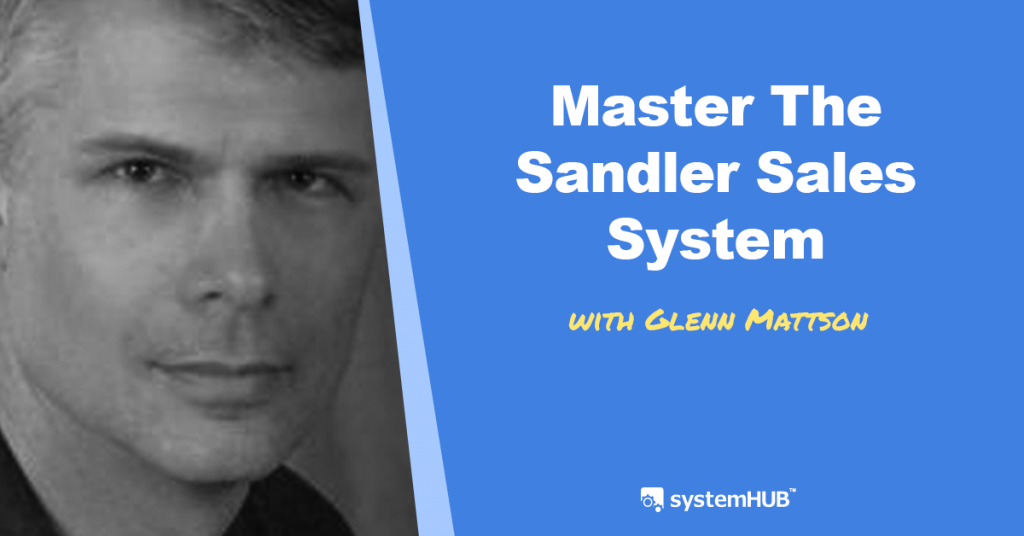Glenn Mattson | The Ultimate Dashboard for High-End Producers
- Department: Sales

Overview
This system aims to help business owners how to sell in a way that people would buy. It is a five-step process that understands the behaviour people make when they buy and reference how a business sells its products/services in alignment with that behaviour.
Understand the buying process of your prospects. Glenn believes that there is a buying process that customers follow when buying, while salespeople follow the sales process.
=-=-=-=-=-=
System Architect: Glenn Mattson
Website: www.sandler.com
Generated as part of the www.BusinessSystemsSummit.com
Video
The Process
The buying process of prospects:
- Mislead or lie to salespeople to maintain control.
- When you sound and look like a salesperson, you will be treated like one.
- Information gathering.
- A mini lie can either be a yes, a no, or a maybe.
- Deal with you after you gave the proposal.
- Hide you in their voice mail.
- You always have to talk to the assistant, your prospect always has a meeting, etc.
There’s always a plan in play and someone who has a stronger plan will always win. Once you’ve understood your prospect’s buying system, you can start constructing your selling system.
Step 1: Bonding rapport.
- Have your enablement team set you up for an appointment with your prospect.
- Prepare fact sheets for you.
- It has three concepts:
- Relationship.
- Qualifying.
- Closing.
Step 2: Upfront contracts.
- The upfront contract is vitally important to create every meeting with your prospect. It ensures that you and your buyer are on the same page.
- Appreciate your prospect with their time.
- Reconfirm the amount of time that you set up for the meeting.
- Uncover your prospect’s agenda and expectations of the meeting.
- Share your own agenda and expectation of the meeting with your prospect.
- Decision or outcome.
- Relieve pressure from your prospect and allow them to say no to you if they see that you’re not the solution for their problem.
- Be sure that you have these three things on your upfront contract:
- Purpose
- Agenda
- Decision
- Adapt yourself to fit your prospect so when you speak, they hear it.
Step 3: Emotional drivers.
- There are only two reasons why people take action to buy something: pain or pleasure.
- There are two phases of time for each reason: now and in the future.
- During the “pain right now”, people spend more money to fix their problems quicker.
- During the “pain in the future” is the second easiest to sell.
- During the “pleasure right now” is harder to sell than “pleasure in the future”.
- There are three personas in your buyer:
- The child – the buying process.
- The adult – the voice who fact checks.
- The parent – the one who confirms if buying is a good decision.
- You should know how to speak to the child, and not the adult and parent as these two represent the intellectual side.
Step 4: Budget.
- This step is basically you talking to the intellectual voices of your prospect.
- Budget is a conversation about three things:
- Do they have the ability to fund it?
- Do they have the willingness to fund it?
- Is there any impact in funding it?
- Techniques on how to uncover budget:
- Learn the skill of when to ask.
- Fix the mindset that makes you uncomfortable asking for your prospect’s budget. Be comfortable talking about money.
- This step revolves around money.
- Who signs it off?
- Where is it coming from?
- What’s the time frame?
- What are the terms?
- Flush out any money issues during this phase.
Step 5: Decision-making process.
- The outcome will depend on the prospect you’re talking to and the number of people involved with the process.
- Keys in the decision-making process to ask your prospect:
- Who, besides yourself, is involved in the decision-making process?
- What kind of process does your company go through to make a decision?
- When do you want to have the solution in play?
- How do you know which is the best one for you?
- When you’ve figured out that there are other people that are part of the process, you’ve got to build rapport with all those other people.
- Qualify your prospects.
- Ask the ultimate contract question – this is the actual proposal.
- Bring the future into the present with the question.
- Get your clients, to be honest with you.
- It eliminates assumptions while giving clarity.
Step 6: Presentation/Fulfillment.
- This step is all about how you are going to solve their pain, within their budget, in front of the decision-makers.
- The fulfilment has 4 steps:
- Always review what you did.
- Show them how you can resolve the problem.
- Close. Dwell on the issues that they want to be solved. If you’ve covered two-thirds of your agenda, pause and confirm your disposition to your prospect before proceeding.
- Make sure that when someone buys, it sticks.
- This is actually the best part of the process because that’s when the fun happens.
- By the end, ask your prospects if they’re sure about their choice. This is to have them hear the reason from themselves.